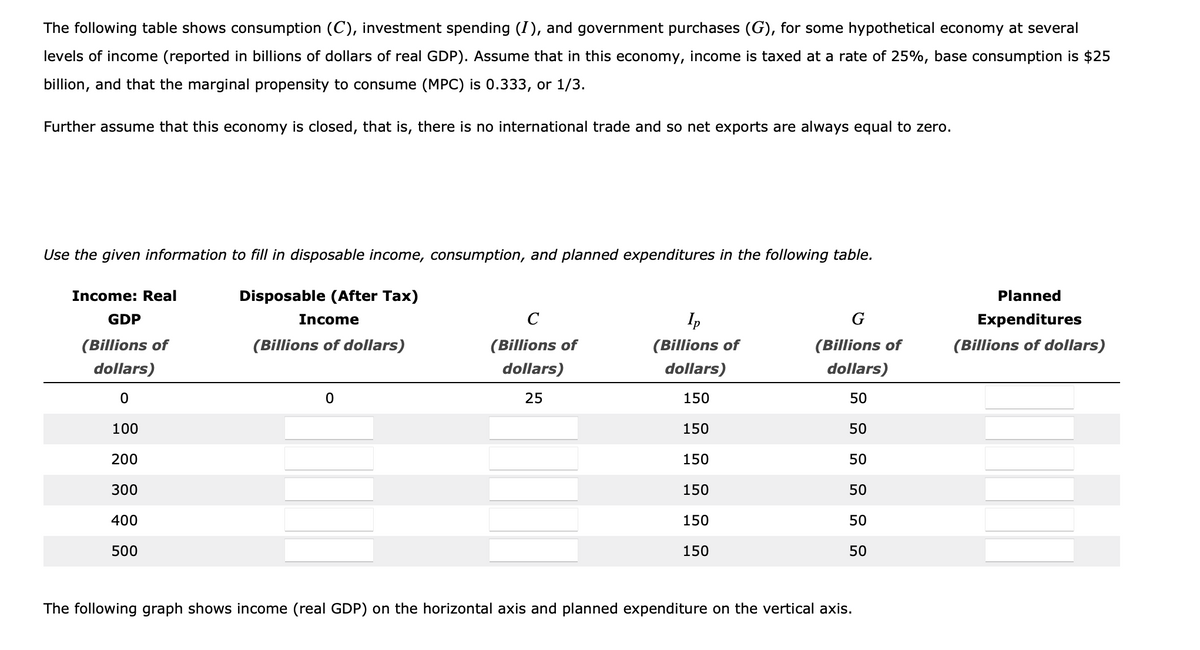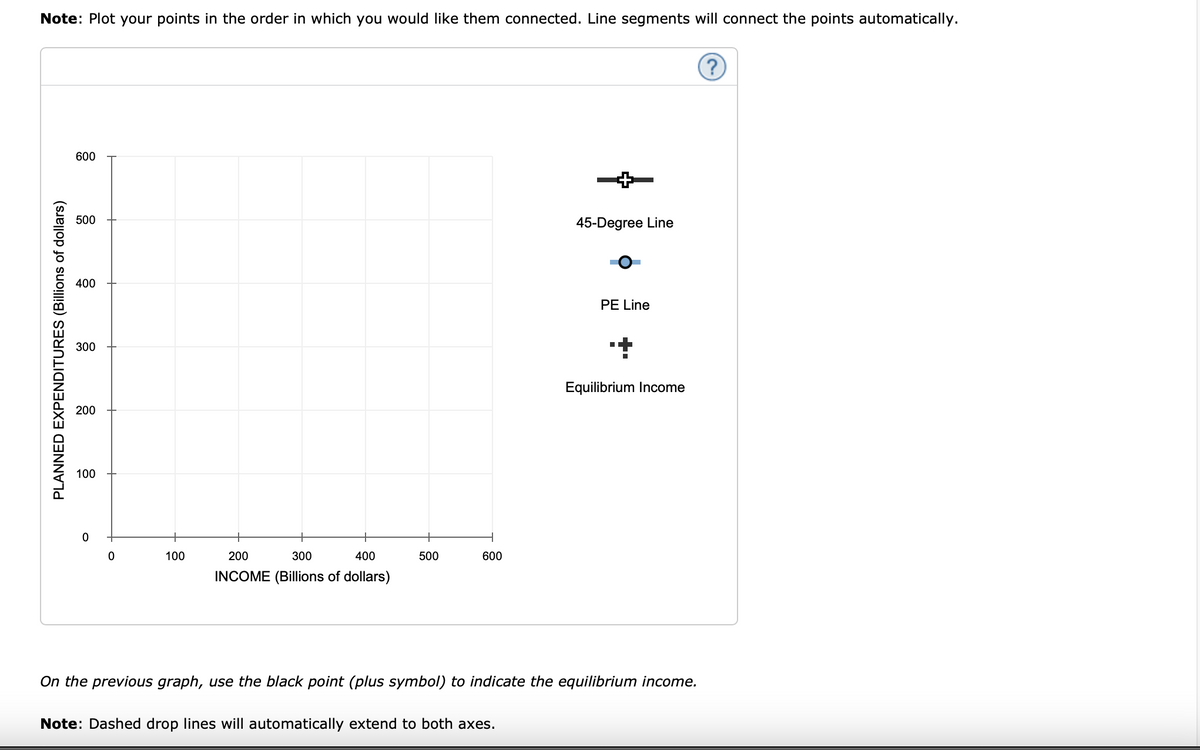The following table shows consumption (C), investment spending (I), and government purchases (G), for some hypothetical economy at several levels of income (reported in billions of dollars of real GDP). Assume that in this economy, income is taxed at a rate of 25%, base consumption is $25 billion, and that the marginal propensity to consume (MPC) is 0.333, or 1/3. Further assume that this economy is closed, that is, there is no international trade and so net exports are always equal to zero. Use the given information to fill in disposable income, consumption, and planned expenditures in the following table. Disposable (After Tax) Income (Billions of dollars) Income: Real GDP (Billions of dollars) 0 100 200 300 400 500 0 с (Billions of dollars) 25 Ip (Billions of dollars) 150 150 150 150 150 150 G (Billions of dollars) 50 50 50 50 50 50 The following graph shows income (real GDP) on the horizontal axis and planned expenditure on the vertical axis. Planned Expenditures (Billions of dollars)
The following table shows consumption (C), investment spending (I), and government purchases (G), for some hypothetical economy at several levels of income (reported in billions of dollars of real GDP). Assume that in this economy, income is taxed at a rate of 25%, base consumption is $25 billion, and that the marginal propensity to consume (MPC) is 0.333, or 1/3. Further assume that this economy is closed, that is, there is no international trade and so net exports are always equal to zero. Use the given information to fill in disposable income, consumption, and planned expenditures in the following table. Disposable (After Tax) Income (Billions of dollars) Income: Real GDP (Billions of dollars) 0 100 200 300 400 500 0 с (Billions of dollars) 25 Ip (Billions of dollars) 150 150 150 150 150 150 G (Billions of dollars) 50 50 50 50 50 50 The following graph shows income (real GDP) on the horizontal axis and planned expenditure on the vertical axis. Planned Expenditures (Billions of dollars)
Chapter9: Demand-side Equilibrium: Unemployment Or Inflation?
Section: Chapter Questions
Problem 2DQ
Related questions
Question
The following table shows consumption (C), investment spending (I), and government purchases (G), for some hypothetical economy at several levels of income (reported in billions of dollars of real GDP). Assume that in this economy, income is taxed at a rate of 25%, base consumption is $25 billion, and that the marginal propensity to consume (MPC) is 0.333, or 1/3.
Further assume that this economy is closed, that is, there is no international trade and so net exports are always equal to zero.
Use the given information to fill in disposable income, consumption, and planned expenditures in the following table.
|
Income: Real GDP
|
Disposable (After Tax) Income
|
C
|
Ip
|
G
|
Planned Expenditures
|
|---|---|---|---|---|---|
|
(Billions of dollars)
|
(Billions of dollars)
|
(Billions of dollars)
|
(Billions of dollars)
|
(Billions of dollars)
|
(Billions of dollars)
|
| 0 | 0 | 25 | 150 | 50 |
|
| 100 |
|
|
150 | 50 |
|
| 200 |
|
|
150 | 50 |
|
| 300 |
|
|
150 | 50 |
|
| 400 |
|
|
150 | 50 |
|
| 500 |
|
|
150 | 50 |
|
The following graph shows income (real GDP) on the horizontal axis and planned expenditure on the vertical axis.
Use the black line (plus symbol) to plot a 45-degree line on this graph. Then use all 6 of the the blue points (circle symbols) to plot the planned expenditure line for this economy. Be sure to plot these points at the income levels listed in the table (0, 100, 200, 300, 400, and 500 billion dollars).
On the previous graph, use the black point (plus symbol) to indicate the equilibrium income.
Note: Dashed drop lines will automatically extend to both axes.
Suppose income is currently $100 billion. This would mean that , which would send a signal to firms to .

Transcribed Image Text:The following table shows consumption (C), investment spending (I), and government purchases (G), for some hypothetical economy at several
levels of income (reported in billions of dollars of real GDP). Assume that in this economy, income is taxed at a rate of 25%, base consumption is $25
billion, and that the marginal propensity to consume (MPC) is 0.333, or 1/3.
Further assume that this economy is closed, that is, there is no international trade and so net exports are always equal to zero.
Use the given information to fill in disposable income, consumption, and planned expenditures in the following table.
Income: Real
GDP
(Billions of
dollars)
0
100
200
300
400
500
Disposable (After Tax)
Income
(Billions of dollars)
0
с
(Billions of
dollars)
25
Ip
(Billions of
dollars)
150
150
150
150
150
150
G
(Billions of
dollars)
엉엉엉엉엉엉
50
50
50
50
50
50
The following graph shows income (real GDP) on the horizontal axis and planned expenditure on the vertical axis.
Planned
Expenditures
(Billions of dollars)

Transcribed Image Text:Note: Plot your points in the order in which you would like them connected. Line segments will connect the points automatically.
PLANNED EXPENDITURES (Billions of dollars)
600
500
400
300
200
100
0
0
100
200
300
400
INCOME (Billions of dollars)
500
600
45-Degree Line
Note: Dashed drop lines will automatically extend to both axes.
PE Line
++
Equilibrium Income
On the previous graph, use the black point (plus symbol) to indicate the equilibrium income.
?
Expert Solution
This question has been solved!
Explore an expertly crafted, step-by-step solution for a thorough understanding of key concepts.
This is a popular solution!
Trending now
This is a popular solution!
Step by step
Solved in 4 steps with 2 images

Knowledge Booster
Learn more about
Need a deep-dive on the concept behind this application? Look no further. Learn more about this topic, economics and related others by exploring similar questions and additional content below.Recommended textbooks for you

